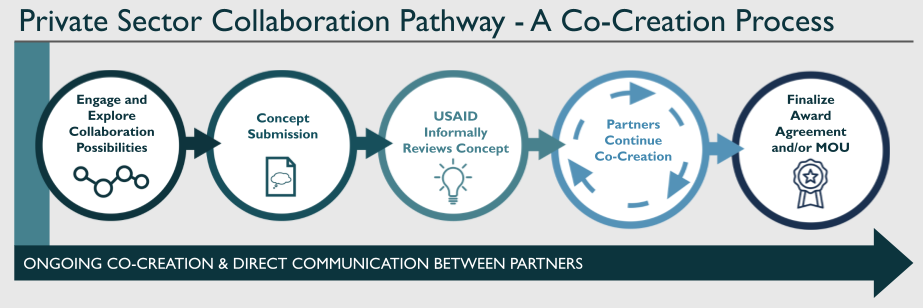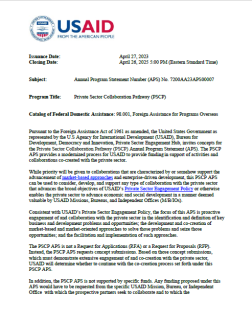Private Sector Collaboration Pathway
Annual Program Statement (APS)
Collaboration between USAID and the private sector is a critical lever in spurring development-positive business and driving sustainable impact. For decades, USAID has worked together with businesses and other private sector entities, leveraging and applying respective assets and expertise to achieve shared goals through market-based approaches. However, there remains massive outstanding potential for further collaboration. The Private Sector Collaboration Pathway is a new tool in the partnering toolbox that will help USAID and our potential partners more easily and effectively tap into that opportunity.
By joining with USAID, businesses and other private sector entities can leverage USAID’s capabilities, expertise, networks, and other assets to advance their core interests and achieve greater success. Past collaborations have enabled private sector partners to improve supply chain quality and reliability, expand access to new customer bases and markets, reduce operating costs, improve workforce productivity, increase access to qualified and skilled talent, and enhance the business enabling environment.
What is the Private Sector Collaboration Pathway?
The Private Sector Collaboration Pathway is an open invitation to businesses and other private sector entities to co-create solutions alongside USAID that achieve sustained development impact and foster business success. The pathway was developed to facilitate effective collaboration to best reach our shared goals.
How do partners use co-creation to generate shared value?
Effective collaborations are built at the intersection of business interests and USAID development and humanitarian objectives. Collaborations leverage partners’ respective assets — experience; creativity; capital and investments; market knowledge, access and influence; business presence and operations; governmental and regulatory experience and relationships; community experience and relationships; and more — to solve complex problems facing governments, businesses, and communities. The following are critical to the process of building successful collaborations:
- Identify Shared and Complementary Interests: This collaborative approach to partnership relies heavily on the identification of aligned or complementary interests between business, USAID, and other organizations with a stake in promoting broad-based social and economic development. Determining where interests align provides the foundation for the private sector and USAID to explore how to work together to address business challenges and opportunities, while advancing sustainable development impact.
- Establish Shared Objectives, Responsibility, and Resource Contributions for Sustained Impact: Building on the understanding of complementary interests, partners determine whether and how their business and development objectives align, define challenges and risks, and identify solutions using market-based approaches such as building more inclusive and effective systems and improving operating environments. Collaborations then define roles and responsibilities based on respective strengths and capabilities that work to best leverage the partners’ assets, abilities, and expertise. The level and content of these contributions are determined through co-creation.
- Co-Create and Communicate Directly and Throughout the Process: Effective collaboration involves robust and continual communication and coordination between USAID and private sector partners in order to achieve the greatest degree of business value and sustainable development impact.
Overall, the process for collaboration is as follows:

What is the relationship between the Global Development Alliance (GDA) and the Private Sector Collaboration Pathway?
This is the successor of the Global Development Alliance (GDA) Annual Program Statement (APS), building on the strengths of that process while providing new flexibilities and user experience improvements. Everything that was possible under the GDA APS is now possible with the Private Sector Collaboration Pathway APS. Hence, the GDA APS will no longer be available after August 31, 2023. In the meantime, USAID strongly encourages the use of the Private Sector Collaboration Pathway rather than the GDA APS. For any questions or concerns, please email pscp@usaid.gov.
Who can be potential collaborators with USAID through the Private Sector Collaboration Pathway?
The Private Sector Collaboration Pathway requires that a private sector entity be a core participant in the collaboration. Direct communication between the private sector entity and USAID is necessary at the outset of any such collaboration and throughout the process.
Private Businesses: Any private business including multinational, regional, national or local; this may include banks or other financial institutions.
Other Private Sector Entities: Business and trade associations, pension funds and institutional investors, private equity funds and other finance providers, corporate foundations, etc.
Collaborations can also include other entities in addition to USAID and the private sector entity such as national and international non-governmental organizations (NGOs), government entities including host country governments, states and cities, other U.S. government agencies and other national donors; multinational groups including the UN, World Bank, IMF; colleges and universities; public foundations and philanthropic individuals; diaspora organizations; advocacy groups and civic groups. While such entities do not themselves meet the private sector partnering requirement under the Private Sector Collaboration Pathway, they could have valuable roles to play in the success of the collaboration between USAID and the private sector.
NOTE: Please see Section III of the Private Sector Collaboration Pathway APS for more information about the private sector partner requirement as well as eligible applicants and awardees.
How is a collaboration between USAID and the private sector initiated?
Collaborations can be initiated by USAID, the private sector, or some other organization interested in advancing collaboration between USAID and the private sector. In fact, collaboration is usually initiated simply by USAID and a potential partner having initial communication about working together. At that point, it would be determined whether continuation of the communication is best pursued under the Private Sector Collaboration Pathway or some other channel. The Private Sector Collaboration Pathway is created specifically to be broadly applicable and useful for collaborations between USAID and private sector partners. However, USAID Mission, Bureau, and Independent Offices (MBIOs) also have additional pathways available to them which, depending on the needs of the collaboration, may be more appropriate (for example, MBIOs may issue PSE-focused RFAs, RFPs or a bespoke APS). Hence, the best pathway will be determined through co-creation.
USAID, through its MBIOs may issue a more specific call for particular types of collaboration to address select geographies, priorities and/or objectives. These more specific calls are known as Addenda. All current Addenda to the Private Sector Collaboration Pathway are posted to Grants.gov and can be found here:
If your organization is interested in the opportunities that are published in an addendum, please read the addendum carefully and follow the instructions set forth therein. Please direct any general questions about addenda to pscp@usaid.gov.
How can interested businesses or other prospective private sector partners initiate a collaboration?
If your business is interested in initiating a collaboration with USAID, please reach out:
Connect with us: If your company or organization is interested in exploring a collaboration with USAID, the first step is to connect with the Mission staff in your country of interest or appropriate DC bureau by following the instructions here. If this list does not provide a contact that meets your needs, please feel free to contact pseconcierge@usaid.gov.
Understand USAID Priorities: It is useful for prospective private sector partners to have a broad understanding of USAID priorities and objectives prior to consulting with the USAID Mission, Bureau, or Independent Office with which the partner seeks to build a collaboration.
- USAID country offices are called Missions. Each Mission develops a specific Country Development Cooperation Strategy which clearly states USAID’s priorities and objectives in that country. The strategies are all accessible here:
- USAID’s overall development priorities and objectives for collaboration with companies and other private sector entities are found in the Private Sector Engagement Policy:
Further Understand the Private Sector Collaboration Pathway
If through your discussions with USAID staff, your collaboration identifies the Private Sector Collaboration Pathway as the best way forward or you would simply like to learn more about the process, please feel free to read the document found here:
USAID is excited to explore additional collaborations with businesses and other private sector entities. If your company or organization is interested in exploring a collaboration with USAID please connect with us here or if you have any additional questions please contact pscp@usaid.gov.
Related Links
Private Sector Engagement and Due Diligence - Prior to signing an Agreement or Memorandum of Understanding (MOU), USAID is required to conduct due diligence on prospective partners. The following guidance document is primarily for USAID personnel but is publicly available to help partners understand the due diligence process.

